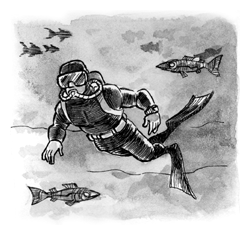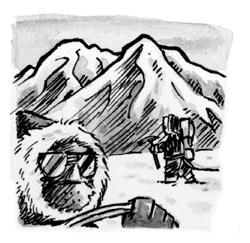Deadly Ascent
|  |
Student Handout
|
Going to Extremes
The world offers many exciting places to travel. But some of the world's most
beautiful places—rainforests, deserts, deep ocean environments, and
mountaintops—are also the most remote. Many of these environments require
extreme caution. In this activity learn about some of the extreme places you
can go on Earth, some of the dangers you can encounter, and some of the ways
you can deal with those dangers.
Check Out the Glossary
If
there is a word you come across that you don't understand, try looking for it
in the Glossary on your "Extreme Survival" handout.
 Grand Canyon National Park
Grand Canyon National Park
Arizona, United States
Get your hat out, because if it's summer, it's going to be hot. In July,
maximum temperatures range from 25° to 41° C, depending where you are
in the canyon. Despite the heat, the park is home to a diverse range of
species, including 50 species of reptiles. You should watch out for some of
those creatures, particularly the rattlesnakes. If you are one of the
unfortunate few people to get bitten by the most common rattlesnake, the
western diamondback, you will likely have a rubbery taste in your mouth, and
feel weak and nauseous when the poison enters your bloodstream. Dehydration is
one of the biggest threats here. Drink plenty of water to replenish what you
lose due to sweating but watch out for hyponatremia. Be careful when you hike
as well; don't hike the inner gorge in the summer when you may get
hyperthermia. If you're hiking during the winter months, make sure you bring
cold weather gear, for night temperatures are cold enough to cause your core
body temperature to drop below 35° C. During the day, you will surely want
to get pictures of the unique variety of rocks and geological features. But be
careful of those rocks; they can form rock landslides. And if there is a storm,
watch out for lightning strikes or flash floods.
 Pacific Ocean
Pacific Ocean
The Pacific Ocean covers more than one-third of the Earth's surface. It is
filled with interesting geological features, including plateaus, ridges,
trenches, and seamounts. If you decide you want to go scuba diving to see some
of those, remember that water conducts body heat much faster than air of the
same temperature. If you dive too deep for too long, your body temperature will
drop below 35° C. You're also subject to other dangers while you're down
there, including nitrogen narcosis if you stay down too long, and Caisson's
disease if you ascend too rapidly. If you decide to do some deep-sea fishing,
better make sure you have some protection from the sun. If you get caught
adrift and experience extended exposure, your body temperatures can rise above
41° C. If night falls and you don't have warm clothes or blankets, you
face a different problem—cold temperatures that put you at risk for
hypothermia. And at any time of the day, you are subject to hazards that
include typhoons and tidal waves. Even under normal weather conditions, ocean
wave heights can easily reach eight meters, so take care or you may get mal
de mer, where your brain and inner ear have a different take on just how
stable the world is.
 Amazon Jungle
Amazon Jungle
South America
Welcome
to the Amazon, the wettest area in South America.
The
weather is generally hot and humid throughout the year, with average
temperatures ranging from 23° to 33° C. More than one-third of all
the species on Earth live here. And some of those can cause you some problems.
You should take care to watch out for snakes, jaguars, and piranhas, to name a
few. On a smaller scale, it would be good to try to protect yourself from the
mosquitoes (particularly the Anopheles that causes malaria). You might
also see the poison dart frog while wandering around. It was named that for a
reason—the poison it emits is so deadly the equivalent of two to three
grains of table salt is likely to kill a human. Some of the less deadly dangers
you face here are dehydration, diarrhea, and fungus infection. If you travel to
the Amazon, it is likely you will want to see the world's largest water basin,
the Amazon River. You can find the biggest freshwater fish in these waters.
Called the pirarucu, this fish can weigh 250 kilograms and measure up to 2.5
meters in length. There is something else in these rivers, which while much
smaller, may present a bigger problem for you. The rivers contain snails that
carry a worm that cause a disease known as schistosomiasis. You will know you
have it if you develop a rash or itchy skin, fever, chills, cough, and muscle
aches within one to two months of infection.
 Denali
Denali
Alaska, United States
You have arrived at one of the world's seven summits, the highest mountains on
each of the world's continents. The National Park and Preserve that contains
Denali (also known as Mt. McKinley) boasts more than 2.4 million hectares of
land. First climbed in 1913, Denali is 6,194 meters high, making it the highest
peak in North America. And with temperatures that can fall below -40° C in
winter, it is also one of the coldest mountains in the world. This can give you
a serious case of hypothermia. Despite the frigid temperatures, if you exert
yourself too much you can get too hot. When this happens, your body's core
temperatures can reach dangerous levels of more than 41° C. If you look
around you may spot grizzly bears, wolves, and moose. Careful how close you get
to any of those, however, as they could all pose some problems for you. If you
decide to try to summit this mountain, be careful as you get to the higher
altitudes. If you start to get a headache; lose your appetite; and feel
nauseous, weak, and dizzy, you may have Acute Mountain Sickness (AMS). Other
dangers here include frostbite, hypoxia, and High Altitude Pulmonary Edema
(HAPE).
|